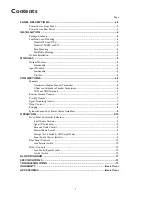
Connections
COM and GND Terminals
A shorting jumper typically connects the COM and GND terminals of
the amplifier together. The COM terminal is a common lead from the
output transformer. For the transformer-coupled speaker output to
work, one of the speaker load leads must be connected to this terminal.
The GND terminal is a connection to the system’s electrical ground and
used when driving loads in the Direct Out mode.
Connecting the GND to the COM terminal when using the transformer-
coupled outputs references the transformer output to ground.
Disconnecting the GND terminal from COM allows the transformer
output to float electrically. This is sometimes useful under certain
conditions where a ground connection is undesirable. It is generally a
good idea to short the GND to the COM terminal regardless of output
type (Trans or Direct).
Remote Volume Control
Three terminals are provided for remote control of the Master Volume
control on the front panel.This control is motorized, allowing full con-
trol over the setting of the master volume. Shorting the UP terminal
with the C terminal will rotate the Master Volume control in a clockwise
direction, increasing the volume level. Shorting the DN terminal to the
C terminal will cause the Master Volume control to rotate in a counter-
clockwise direction and decrease the level of the Master Volume control.
The impedance of the shorting connections must be less than
1
00 ohms
in order to operate the control. The Bogen Remote Volume Control
Panel (Model RVCP) provides a simple and elegant means of remote
control. Alternatively, a SPDT spring-loaded, center off switch or two
SPST push-button switches can provide the necessary contacts for
remote control.
Pre-EQ Output
An unbalanced RCA connector provides a buffered signal level output for
use by external equipment. This output signal includes all internal signal
processing, including master volume control, output modules processing,
tone controls, and low-cut filtering. It does not include any external
signal processing that may be provided through the Signal-Processing
Inserts.
Signal-Processing Inserts
A set of unbalanced RCA connectors provides a means to insert
external signal-processing equipment between the output of the Power
Vector Amplifier’s mixer section and its power amp section. The RCA
connector labeled OUT provides a signal from the amplifier’s mixer
section. This output signal encompasses all internal signal processing,
including master volume control, output modules processing, tone
controls, and low-cut filtering.The connector labeled IN provides an input
to the amplifier’s power amplifier section. The internal connection
between the amplifier’s mixer section and power amp section is
automatically broken whenever an RCA plug is inserted into the IN
connector.
7
Содержание Power Vector V100
Страница 13: ...Block Diagram 11 ...


































